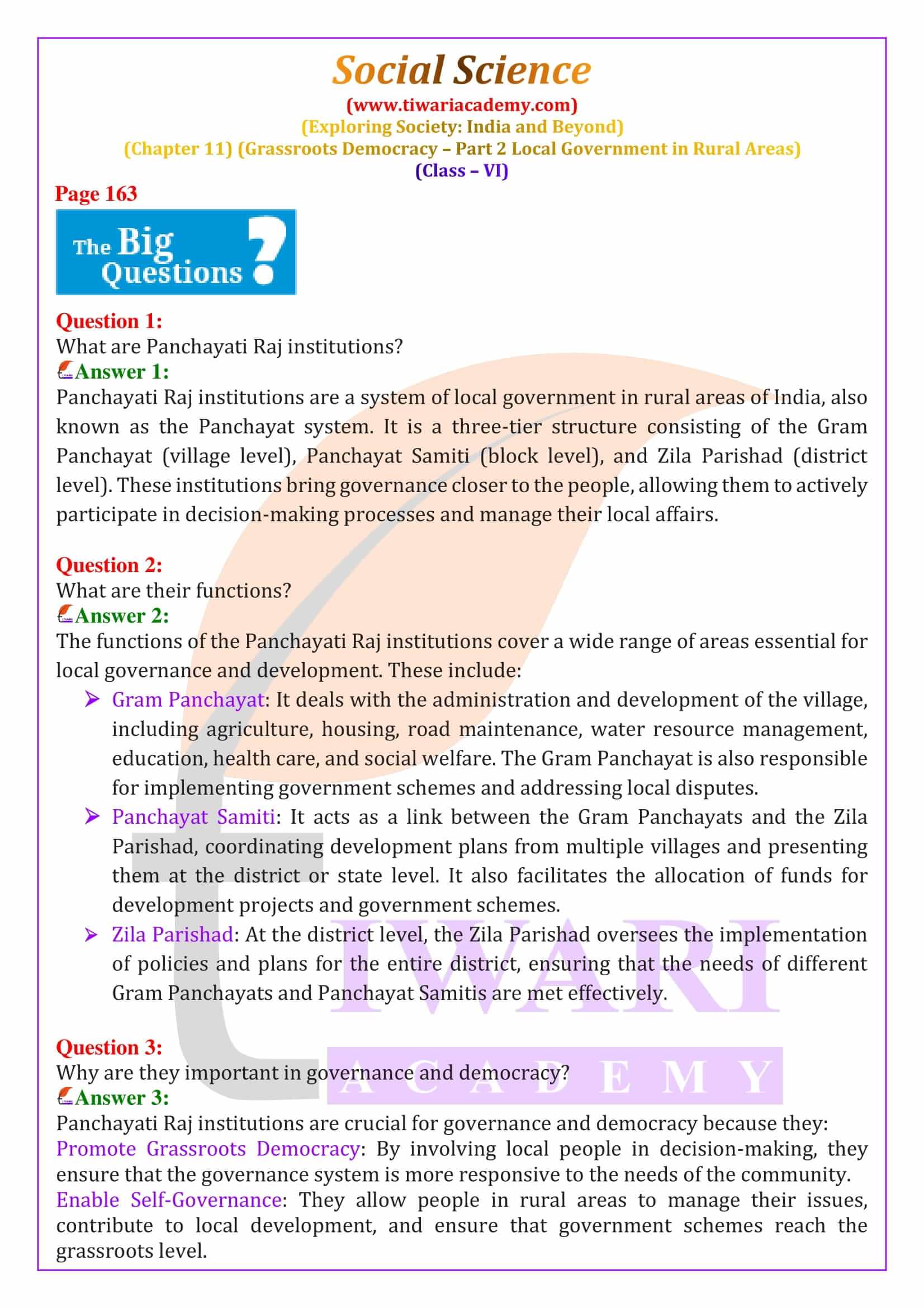NCERT Solutions for Class 6 Social Science Chapter 11 Grassroots Democracy — Part 2: Local Government in Rural Areas updated for session 2025-26. Class 6 Social Science Chapter 11 Exploring Society – India and Beyond India Beyond in Civics (Political Science) Section Question Answers of exercises are given here.
Class 6 Social Science Chapter 11 Grassroots Democracy – Part 2: Local Government in Rural Areas Question Answers
Grassroots Democracy – Part 2: Local Government in Rural Areas Introduction
The chapter 11, Grassroots Democracy — Part 2: Local Government in Rural Areas, introduces students to the concept of local government in rural India. It highlights the importance of governance at the village level, where most of India’s population resides. The chapter begins by explaining the need for a system that allows villagers to manage their daily issues, like water supply, road maintenance, and school upkeep, without always relying on state or national governments. This is where the Panchayati Raj system comes in, offering a structure for self-governance at the grassroots level.
Panchayati Raj System: An Overview
The Panchayati Raj system is a three-tier structure that ensures governance reaches even the smallest villages in India. The three levels are the village, block, and district levels, each with its own council or Panchayat. At the village level, the Gram Panchayat is directly involved in addressing local needs, while the Block Panchayat (Panchayat Samiti) and District Panchayat (Zila Parishad) work on broader regional issues. This system allows villagers to actively participate in decision-making processes that affect their daily lives and ensures that development is tailored to local needs.
The Gram Panchayat: Foundation of Rural Governance
The Gram Panchayat is the most basic unit of the Panchayati Raj system and is closest to the people. Members of the Gram Panchayat are elected by the Gram Sabha, which includes all adults in the village. The head of the Gram Panchayat is called the Sarpanch or Pradhan, and in recent years, many women have taken on this leadership role. The Gram Panchayat is responsible for addressing local issues, such as infrastructure maintenance, education, and health, and ensuring that government schemes reach the villagers.
Women and Exemplary Leaders in Panchayats
The chapter 11 highlights the importance of women and other exemplary leaders in the Panchayati Raj system. It shares stories of individuals like Dnyaneshwar Kamble, a transgender Sarpanch, and Vandana Bahadur Maida, a female Sarpanch who challenged societal norms to bring positive change to their villages. These stories illustrate how the Panchayati Raj system empowers diverse voices and shows the potential for leadership at the grassroots level to transform communities.
Child-Friendly Panchayats: Including the Young Voices
Class 6 Social Science chapter 11 also discusses the Child-Friendly Panchayat Initiative, which encourages the participation of children in governance. This initiative allows children to voice their concerns in Bal Sabhas and Bal Panchayats, where they can discuss issues like education, sanitation, and child rights. The involvement of children in local governance not only helps address their needs but also teaches them about democracy and social responsibility from a young age.
Panchayat Samiti and Zila Parishad: Coordination at Higher Levels
Beyond the village level, the Panchayat Samiti and Zila Parishad play crucial roles in coordinating efforts across multiple villages and blocks. The Panchayat Samiti at the block level acts as a bridge between the Gram Panchayats and the Zila Parishad, ensuring that local development plans are integrated and presented for funding and implementation. The Zila Parishad, at the district level, oversees larger-scale projects and policies that affect the entire district, ensuring that rural development is well-coordinated and effective.
The Role of Panchayati Raj in Rural Development
The Panchayati Raj system is essential for promoting self-governance in rural areas, enabling villagers to manage their own development and address local issues. While the structure and functions of Panchayati Raj institutions may vary across states, their core objective remains the same: to empower rural communities and ensure that governance is inclusive and responsive to the needs of all, including the disadvantaged sections of society. This system of grassroots democracy helps bridge the gap between the government and the people, making it a vital component of India’s democratic framework.








